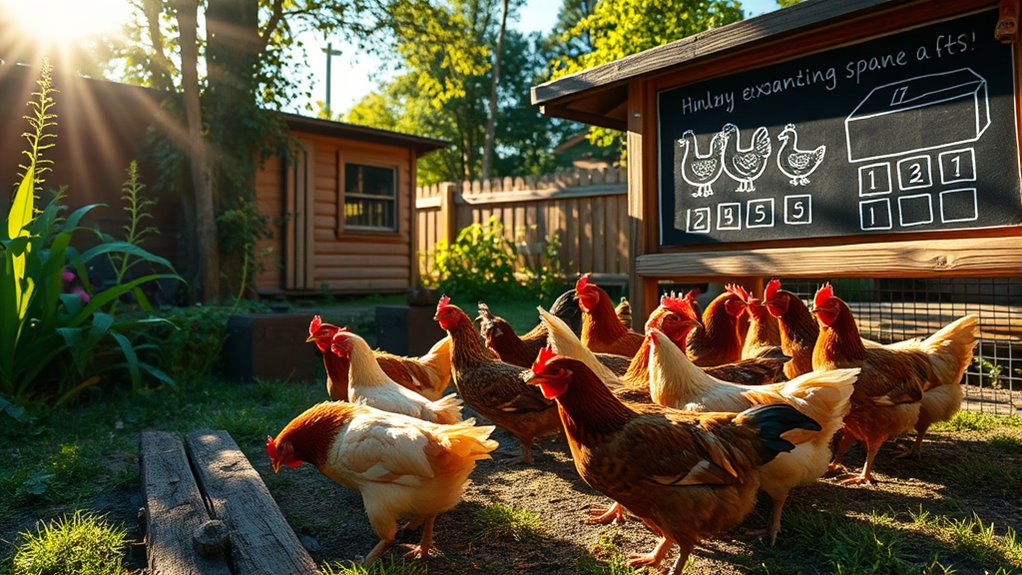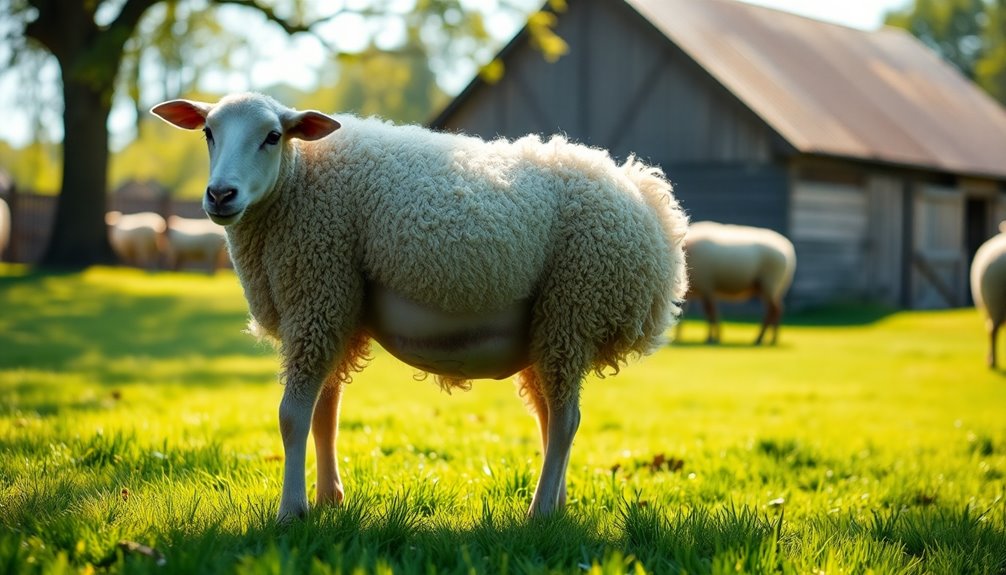To determine how many chickens you need, start by checking local regulations, including zoning laws and coop size. Assess your available space; each regular chicken needs 3-5 square feet in the coop and 10 square feet in the run. Clarify your purpose—whether for eggs or meat—to decide on breeds and flock size. Factor in costs for housing, feed, and care. If you keep going, you'll discover more tips to help you with your chicken journey.
Key Takeaways
- Determine your purpose for keeping chickens, such as egg production or meat, to guide flock size and breed selection.
- For egg production, consider your weekly consumption to decide the number of hens needed, typically one hen lays about 5-6 eggs per week.
- Account for space requirements, needing 3-5 square feet per chicken in the coop and 10 square feet in the run.
- Assess local regulations for zoning laws, coop size, and potential permits to ensure compliance before starting your flock.
- Budget for initial costs, including housing, feed, and equipment, to understand the financial commitment involved in chicken keeping.
Local Regulations to Consider

Before you decide how many chickens to keep, it's essential to understand the local regulations that may affect your plans.
Zoning laws can vary significantly by city and county, influencing the number of chickens you can have. In residential zones, there are often restrictions on coop size and placement, while agricultural zones typically have fewer limitations.
Be mindful of setback requirements from property lines and neighboring homes. Some cities may require permits, which could involve fees. Additionally, homeowners associations might impose their own rules, so check your HOA bylaws.
It's crucial to stay informed about these regulations to ensure compliance and avoid penalties, allowing you to enjoy chicken keeping without any legal hassles.
Evaluating Available Space

When planning your chicken flock, evaluating available space is crucial to ensure a healthy and comfortable environment for your birds.
Regular-sized chickens need at least 3 to 5 square feet of coop space, while small breeds like Bantams require about 2 square feet each. For outdoor runs, aim for a minimum of 10 square feet per chicken; larger breeds may need even more.
Regular-sized chickens require 3 to 5 square feet in the coop, while Bantams need about 2 square feet each.
If you're in a colder climate, remember to increase your coop size.
Calculating total space is essential: for six medium-sized chickens, you'll need roughly 18 square feet in the coop and 60 square feet in the run.
Starting with extra space allows for future flock expansion and keeps your chickens happy and stress-free.
Determining Your Purpose for Keeping Chickens

Have you thought about why you want to keep chickens? Knowing your purpose helps you determine how many to raise.
If you're after egg production, consider breeds like Rhode Island Reds or Buff Orpingtons, which can yield up to 300 eggs a year. Assess your family's weekly egg consumption to figure out the right number.
For meat, breeds such as Cornish Cross are popular, but remember they need more space.
If you're looking for companionship, friendly breeds can provide emotional support and entertainment.
Chickens also make great pest controllers, enriching your garden while managing insects.
Whatever your reason, defining your purpose will guide your chicken-keeping journey effectively.
Budgeting for Your Chicken Flock

Understanding your purpose for keeping chickens sets the stage for effective budgeting.
Begin by estimating initial costs, like housing, which can run around $500 for a coop and $250 for fencing.
Don't forget feeders and waterers, costing between $75 and $250, and chicks that range from $1 to $2.50 each.
As your flock grows, factor in feed expenses, with layer feed costing about $11 per 50 lb bag.
Additionally, prepare for miscellaneous costs, including heat bulbs and slaughter fees.
Regularly assess your labor needs; caring for a small flock takes about 15 to 30 minutes daily.
Finally, keep in mind potential mortality rates and their impact on your budget to ensure a sustainable chicken-keeping experience.
Understanding Health and Nutrition Needs

To ensure your chickens thrive, it's crucial to grasp their health and nutritional needs. They require a diet with 16-18% protein for optimal egg production and essential amino acids like lysine and methionine for overall health.
Calcium is vital too—at least 2.75% is necessary for strong eggshells. Keep fiber content below 10% for proper digestion, and ensure they get enough vitamin D for bone health.
Recognizing when to supplement is key. While complete layer feeds usually suffice, free-ranging or breeding chickens might benefit from additional vitamins and minerals.
Monitor their health through egg production and droppings quality, and remember that regular checks for parasites and proper nutrition can prevent common diseases. Healthy chickens lay better eggs!
Recommended Flock Sizes for Beginners

For beginners, starting with 3 to 6 chickens is often ideal. This number allows your flock to socialize effectively, reducing loneliness and potential behavioral issues.
Each chicken needs about 4 square feet of coop space and 10 square feet of outdoor run area. With 3 to 6 birds, you can expect around a dozen eggs per week, perfect for a small family.
Starting small helps you manage costs, as initial expenses for construction and chicks are lower. It also reduces stress for both you and your chickens, making it easier to learn.
Plus, you can adjust your flock size later as you gain experience. This flexibility sets you up for success in your chicken-keeping journey.
Choosing the Right Breeds

Once you've settled on your flock size, the next step is selecting the right breeds that fit your needs and environment.
After determining your flock size, it's time to choose the breeds that best suit your needs and surroundings.
If you're focused on egg production, consider Leghorns for their high yield or Australorps for their friendly nature and prolific laying.
For meat, Cornish Cross is a fast-growing option, while Plymouth Rocks serve dual purposes.
If you're in a colder climate, breeds like Wyandottes and Brahmas will thrive. In warmer areas, Leghorns and Cream Legbars adapt well.
If you're looking for friendly pets, Buff Orpingtons and Silkies are excellent choices.
Evaluate your priorities—egg production, meat, climate, or companionship—to make the best breed selection for your flock.
Planning for Future Expansion

As you consider expanding your poultry operation, it's crucial to evaluate various factors that will influence your success.
Start by assessing your land requirements; a larger facility may need over 400 hectares for waste disposal. Plan for buffer zones of at least 100 meters from property lines to meet health and environmental standards.
Think about your farm layout, ensuring it supports bird health and biosecurity while allowing for future scalability. Keep local zoning regulations in mind to avoid compliance issues.
Evaluate the economic feasibility by analyzing initial investment costs and potential market conditions.
Finally, incorporating efficient production technologies can significantly enhance your operation's productivity and sustainability, setting you up for successful expansion in the long run.
Preparing for Chicken Care and Maintenance

Preparing for chicken care and maintenance requires careful attention to several key aspects to ensure your flock thrives.
Start with a spacious coop, allowing 3-4 square feet per chicken, and provide a secure run for exercise. Ensure proper ventilation and maintain temperatures between 65–75°F, adding shade in warmer climates.
Feed your chickens a balanced diet with fresh water and occasional treats, avoiding toxic foods.
Keep the coop clean by spot cleaning daily and replacing bedding monthly. Regularly check your chickens' health and quarantine newcomers for at least 10 days.
Lastly, maintain your coop by inspecting for damage and ensuring predator protection. These steps will help create a healthy environment for your chickens.
Frequently Asked Questions
Can I Keep Chickens in an Apartment or Condo?
You generally can't keep chickens in an apartment or condo due to zoning laws and space limitations.
Most cities prohibit it because of noise and sanitation concerns. Chickens need adequate space, coops, and proper ventilation, which are hard to manage in small living areas.
Plus, local regulations often require permits, and homeowners associations may have rules against them.
If you're interested, consider checking community gardens or urban farming initiatives for alternatives.
What Are the Best Chicken Breeds for Children?
Imagine a backyard where gentle giants roam, each one a friend to your child. For a harmonious experience, consider breeds like the Buff Orpington, with its calm demeanor, or the friendly Brahma, perfect for little hands.
The playful Plymouth Rock and the quirky Silkie also shine in this feathered family. These breeds not only bring joy but teach responsibility, nurturing a bond between your kids and their new, clucking companions.
How Do I Socialize My Chickens Effectively?
To socialize your chickens effectively, start by gently handling chicks to build trust.
Use food to create positive associations and provide a stimulating environment for exploration.
For adult chickens, approach them calmly and reward their interactions with treats.
Establish a consistent routine to help them feel secure, and be patient as building trust takes time.
Regular interaction and gentle affection will reinforce your bond and encourage a friendly flock dynamic.
What Should I Do if My Chickens Stop Laying Eggs?
If your chickens stop laying eggs, first check for health issues like parasites or diseases.
Ensure their coop is clean and well-ventilated to prevent respiratory problems.
Look out for environmental stressors, such as overcrowding or extreme weather.
Assess their diet for nutritional deficiencies, and consider their age and seasonal factors.
Lastly, monitor flock dynamics, as bullying or social isolation can also impact egg production.
Address these issues to encourage laying again.
Can Chickens Be Kept With Other Pets, Like Dogs or Cats?
Yes, chickens can be kept with other pets like dogs and cats, but it requires careful planning.
Gradual introductions, proper training, and supervision are essential for harmony. Ensure your pets have ample space, secure enclosures, and are well-fed to reduce the chance of predation.
Choosing docile chicken breeds and monitoring interactions closely helps create a peaceful environment.
With patience and consistency, you can foster a friendly coexistence between your chickens and pets.
Conclusion
In the end, remember that "good things come to those who wait." Starting your chicken flock is an exciting journey that requires careful planning and consideration. By understanding local regulations, evaluating your space, and determining your purpose, you'll set yourself up for success. Whether you're looking for fresh eggs or companionship, a little preparation goes a long way. So, gather your resources, choose the right breeds, and soon you'll be enjoying the fruits of your labor!










